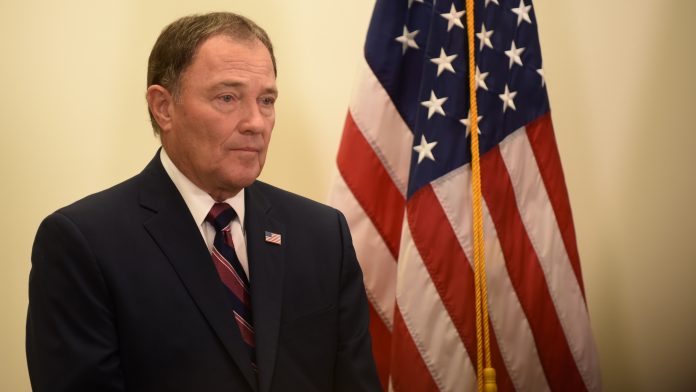SALT LAKE CITY, Utah, July 10, 2020 (Gephardt Daily) – Gov. Gary Herbert is extending his previous executive order mandating the use of face masks in all state facilities.
Herbert’s office Friday also announced an extension Utah’s Health Risk Status, meaning Salt Lake City remains at a Moderate Risk level, while 10 counties remain at the so-called Normal Risk category.
The remainder of the state is classified as Low Risk.
According to Herbert’s statement both orders will remain in effect until July 24 at 11:59 p.m.
Herbert’s executive order is as follows:
EXECUTIVE ORDER Updating Requirements Regarding Face Coverings in State Facilities
WHEREAS, on March 6, 2020, I issued Executive Order 2020-1, declaring a state of emergency to facilitate the State’s response to novel coronavirus disease 2019 (COVID-19);
WHEREAS, on March 13, 2020, Donald J. Trump, President of the United States, issued the Proclamation on Declaring a National Emergency Concerning the Novel Coronavirus Disease (COVID-19) Outbreak;
WHEREAS, COVID-19 is caused by a virus that spreads easily from person to person, may result in serious illness or death, and has been characterized by the World Health Organization as a worldwide pandemic;
WHEREAS, COVID-19 can spread between individuals in close proximity through respiratory droplets produced when an infected individual speaks, coughs, or sneezes;
WHEREAS, an infected individual can transmit COVID-19 even if the individual does not present symptoms;
WHEREAS, the United States Centers for Disease Control and Prevention and the Utah Department of Health have recommended the use of face masks or other face coverings to mitigate the transmission of COVID-19;
WHEREAS, on June 27, 2020, the Utah Transit Authority issued a directive requiring its employees and public transit riders to wear masks or face coverings to protect public health;
WHEREAS, the Utah Department of Health and I have determined that it is appropriate to require individuals, including employees and members of the public, to wear face coverings while in a state facility to protect public health;
WHEREAS, Utah Code $ 53-2a-209(1) provides that orders issued by the governor under Title 53, Ch ter 2a, Part 2, Disaster Response and Recovery Act, have the “full force and effect of law”;
WHEREAS, Utah Code $ 53-2a-204(1)(a) authorizes the governor to utilize all available resources of state government as reasonably necessary to cope with a state of emergency; and
WHEREAS, Utah Code § 53-2a-204(1)(b) authorizes the governor to employ measures and give direction to state and local officers and agencies that are reasonable and necessary for the purpose of securing compliance with orders made pursuant to the Disaster Response and Recovery Act:
1. As used in this Order:
a. “Face covering” means a cloth mask or similar covering that covers the nose and
mouth.
2. “State facility” means any portion of a building or structure, including any part thereof, that is owned, leased, occupied, or controlled by the state or a state governmental entity. “State facility” does not mean:
A. a state prison or state community correctional center;
B. a detention facility or secure facility operated by the Division of Juvenile Justice Services; or
C. a building or structure, or part thereof, that is exclusively owned, leased, occupied, or controlled by:
I. the legislative branch of the state;
II. the judicial branch of the state;
III. the Attorney General’s Office;
IV. the State Auditor’s Office;
V. the State Treasurer’s Office;
VI. an independent entity as defined in Utah Code § 63E-1 102.
1. “State governmental entity” means any department, board, commission, institution, agency, or institution of higher education of the state.
2. Each individual in a state facility shall wear a face covering, except as provided in
Section (3). 3. Section (2) does not apply to:
a. a child who: is in a childcare setting; is younger than two years old; or is two years old or older if the parent, guardian, or individual responsible for caring for the child cannot place the face covering safely on the child’s face.
b. an individual with a medical condition, mental health condition, or disability that prevents wearing a face covering, including an individual with a medical condition for whom wearing a face covering could cause harm or obstruct breathing, or who is unconscious, incapacitated, or otherwise unable to remove the face covering without assistance.
c. an individual who is deaf or hard of hearing, or communicating with an individual who is deaf or hard of hearing, where the ability to see the mouth is essential for communication.
d. an individual who is obtaining a service involving the nose or face for which temporary removal of the face covering is necessary to perform the service; e. an individual who is outdoors.
f. an individual in a vehicle; an individual who is using an indoor recreational facility and maintains a physical
distance of at least six feet from any other individual.
g. an individual who is eating or drinking and maintains a physical distance of at least six feet from any other individual who is not from the same household or residence.
h. a state employee who is not speaking in person with any other individual and who is the sole occupant of a fully enclosed room or office; is the sole occupant of a partially enclosed room, office, or similar space, including a cubicle; that is enclosed on at least three sides by walls or other physical barriers or dividers of a height that reaches no lower than the top of the employee’s head when the employee is seated, or is seated or stationary, and maintains a physical distance of at least six feet from any other individual.
4.
a. Except as provided in Subsections (4)(b) and (4)(c), a state governmental entity may not require an individual to provide medical documentation verifying the basis for an exemption under Subsection (3)(b).
b. A state governmental entity may require an individual employed by the state governmental entity to provide medical documentation verifying the basis for an exemption under Subsection (3)(b). A state institution of higher education may require an individual who is enrolled as a student of the state institution of higher education to provide medical documentation verifying the basis for an exemption under Subsection (3)(b).
5. A state governmental entity may refuse to provide in-person service to any individual who does not wear a mask in a state facility of the state governmental entity if:
a. an alternative means of service is available;
b. the state governmental entity specifies to the individual how to access the
alternative means of service;
6. the state governmental entity determines that the individual has reasonable access to the alternative means of service.
7. The Utah Department of Corrections shall implement requirements regarding the wearing of face coverings in a state prison or state community correctional center.
8. The Division of Juvenile Justice Services shall implement requirements regarding the wearing of face coverings in a detention facility or secure facility operated by the Division of Juvenile Justice Services.
9. This Order rescinds and replaces Executive Order 2020-36.
This Order is declared effective immediately and shall remain in effect until 11:59 p.m. on July 24, 2020, or until otherwise lawfully modified, amended, rescinded, or superseded.







